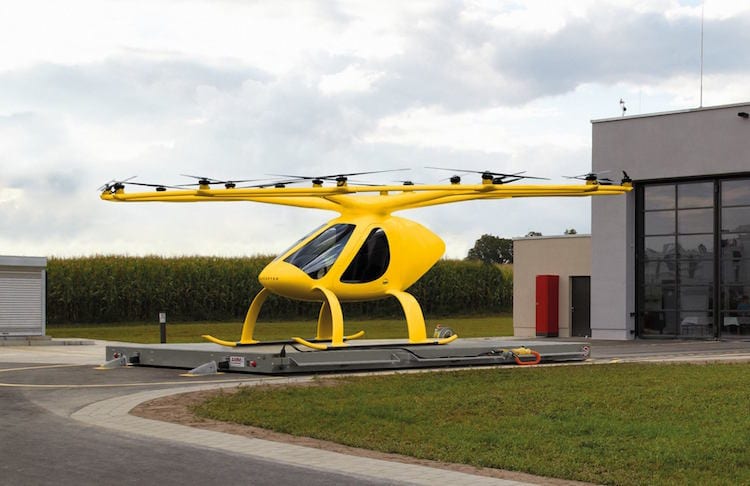
German startup Volocopter’s prototype eVTOL aircraft, pictured here, is one of many eVTOLs in development that could benefit from EASA’s creation of a new air taxi certification category. Photo: Volocopter
The European Aviation Safety Agency (EASA) is considering adding a “special condition” category to deal with the certification of electric and hybrid-electric vertical take-off and landing (eVTOL) vehicles, but the proposal may significantly slow the certification of such vehicles, according to industry observers.
“The special condition has been established to prescribe the technical specifications for the type certification of a person-carrying vertical take-off and landing aircraft in the small category, with lift/thrust units used to generate powered lift and control,” according to a notice by EASA published in October. “The agency considers that the current airworthiness standards for aeroplanes or rotorcraft are not adequate to prescribe the standard means to demonstrate compliance of such products with the essential requirements of the Basic Regulation. Therefore there is a need to develop a dedicated full set of technical specifications in the form of a special condition that can be used to establish the certification basis.”
In the United States, 70 percent of FAR Part 23 regulations would directly fit eVTOL designs, while 30 percent would be “special conditions,” Greg Bowles, the vice president of global innovation at the General Aviation Manufacturers Association, said in an address during the Vertical Flight Society’s 6th Annual eVTOL Symposium in Mesa, Arizona.
While EASA incorporated some Certification Specification-Part 23 (CS-23) regulations, “everything they added we don’t like,” Bowles said, as the proposed regulations would limit design and operational flexibility, including the prohibition of auto-rotation.
If EASA adopts VTOL as a new certification category, eVTOL certifications may get delayed a decade, as European countries would have to ratify the proposal, according to industry observers. In effect, the proposed new regulations would “parse Europe up,” Bowles said during an interview after his address. “Each country would have to figure out their own solutions.”
Bowles said GAMA favors keeping the existing certification framework and certifying eVTOL under that using a term, such as “aeroplane with a vertical lift component.”
The creation of such a framework would benefit companies such as German startup Volocopter, which is currently flight testing its fully electric VTOL aircraft for urban air transport operations in Singapore.
Last November, thirty corporate officials from eight countries met with EASA and other European regulators in Cologne and Brussels to discuss the needs of the emerging eVTOL sector. Dorothee Bär, the German federal state minister for digitization, a major advocate of urban air mobility in Europe, praised the efforts of industry and EASA to develop common standards.
“GAMA believes that EASA should take serious consideration of creating a new vehicle classification ‘VTOL’ in the design rules,” Bowles wrote in a letter to EASA officials four days after the meeting. “Because the European operating construct considers rotorcraft and aeroplanes, determining a VTOL category of aircraft essentially dooms this industry to decades of special approvals and one-off agreements. Many of the vehicles being considered are essentially highly reliable, green and quiet rotorcraft while others are green, reliable, quiet aeroplanes that have an ability to do vertical take-off and landing. It is not a tremendous amount of work to include these vehicles in the existing CS-VTOL, with added special conditions to address the unique VTOL aspects of these vehicles.”
GAMA is to meet with EASA on Feb. 27 to discuss the proposed regulations.